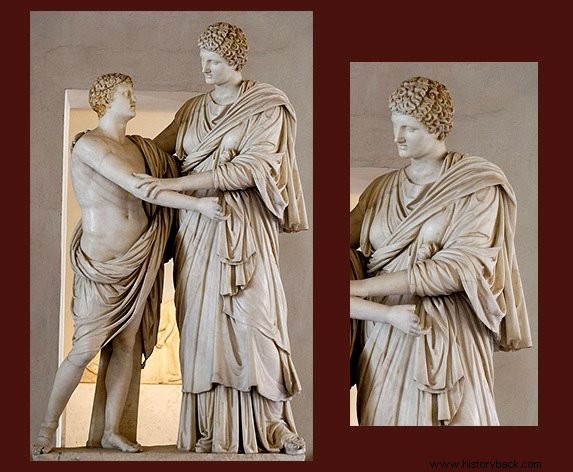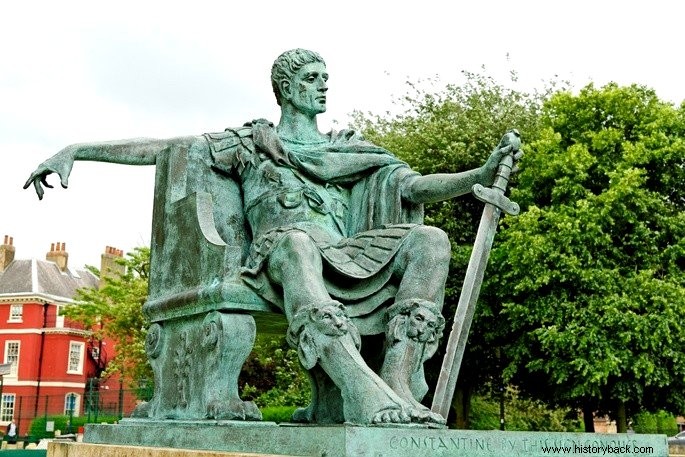Roman sculpture was an extremely significant artistic manifestation in the civilization of Ancient Rome.
It can be said that it is a mixture of classical perfection with features of realism and Eastern styles, which were translated into stone and bronze pieces of unparalleled beauty.
As with painting, the Romans also suffered from Greek influence in sculpture, but they evolved into a style of their own when they came to dominate the world.

Roman sculptors worked in stone, precious metals, glass and terracotta. However, its striking feature is even in bronze and marble. The latter dominates most artworks.
Characteristics of Roman sculpture
- strong influence of Greek and Etruscan art, but with its own Roman elements;
- realistic representations, not an ideal of beauty;
- many works are a fusion of architecture and sculpture;
- representations of Roman Empire deeds on monuments.
 See also:Roman Art
See also:Roman Art Roman copies of sculptures from Greece
Under Greek and Hellenistic influence, copies were very common in Roman sculpture.
The result of such reproductions depended on the skill of the sculptor. There was a craft school for copying in Athens and Rome. Among the directors were Paiteles, Archesilaos, Evander, Glykon and Apollonios.
Examples of copies include the Greek statues of Orestes and Elektra, carved at the end of the 1st century BC. It was the custom of the Romans to produce miniature copies of Greek originals, often bronze.

In the middle of the 1st century AD, Roman artists sought an identity of their own, driven by the conquests of the Roman Empire. In massive bronze sculptures are seen statues of emperors, gods and heroes.
Researchers often say that there are two distinct markets for Roman sculpture.
The first is aristocratic, aimed at the ruling class, with more classic and idealistic sculptures. The second is provincial, aimed at the middle class, more naturalistic and with a type classified as emotional.
Like the Greeks, the Romans also liked to represent their gods in statues. And this custom was not changed when emperors began to compare themselves to gods and claimed divinity.
See also:Greek SculptureStatue of Augustus of Prima Porta
Emperors were portrayed in imposing statues and with a posture of authority, displayed as true gods.
An example is in the statue of Augustus de Prima Porta, the first Roman emperor. Produced around 19 BC, the sculptor sought to portray the real features of this personality. The statue is also adorned with Roman vestments and its arm points firmly to the horizon, as if addressing its subjects.
Less imposing were the statues of the spirits that guarded the houses, usually long-haired figures wearing robes and carved bronze sandals.
 See also:Roman painting
See also:Roman painting Realism in Roman sculpture
The human bust is among the elements that differentiate Roman sculpture from other arts.
Realism is the main feature of the sculptors, with details of scars, skin aging and demonstrations of the effects of time, such as wrinkles.
Roman sculptures gained notoriety through the large statues of emperors, gods and heroes. Examples are the bronze statue of Marcus Aurelius on horseback (3.53 m high) and the statue of Constantine I, both on display at the Capitoline Museum in Rome.
 See also:Roman Mythology
See also:Roman Mythology Roman Architecture
Another trace of Roman grandeur and realism is found in architecture. Entire buildings celebrated victories in military campaigns and domination over the world. This is the case of the Arch of Constantine, built in Rome in the 315th century AD.

Constantine I defeated and enslaved barbarian peoples and his bows demonstrate Rome's superiority. The same is true of Trajan's columns of 113 AD, which reveal a meticulously groomed emperor and an inspiring personality to his troops.
This is a distinguishing mark of Roman art in relation to Greek; while the Roman was characterized by realism, the Greek used mythology to portray its victories.
See also:Roman architectureRoman Funerary Sculpture

Busts and tombstones were also very common in Roman sculpture. Both portrayed the deceased individually and accompanied by his family or slaves.
From the moment burials became more common than cremations, this art developed. The headstones were carved in stone and contained scenes from mythology.
To learn more about the artistic and cultural production of other ancient civilizations, read :
- Egyptian Art
- Romanesque Art
- Greek Art
- Etruscan Art
- Medieval Art
